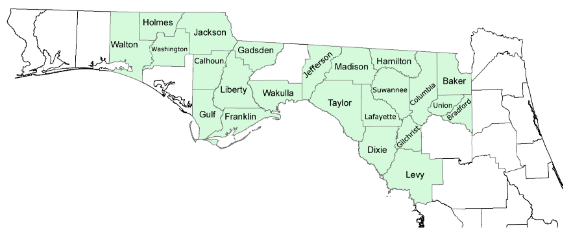Characterizing the Continuum of Care Ecosystem for Neurodiverse Populations in North Florida’s Urban-Rural Regions
It is estimated that 26% of adults in the United States have a disability (Okoro et al., 2018). The legal definition of a disability from the Americans with Disabilities Act of 1990 is a physical or mental impairment that substantially limits one or more major life activity. The World Health Organization (WHO) states that disability results from the interaction between individuals with a health condition, such as cerebral palsy, Down syndrome and depression, with personal and environmental factors, inaccessible transportation and public buildings, and limited social support (World Health Organization). The WHO definition emphasizes the gaps between support needs and environmental factors. These gaps are more prevalent in rural areas, particularly for people with less studied disabilities such as neurodiversity. Neurodiversity is a nonmedical term that refers to a divergence from the neurotypical, expressing differences in human brain activity (Chapman, 2020; Ekblad, 2013). Neurodiverse people include those with autism spectrum disorder (ASD), attention deficit hyperactivity disorder, dyslexia, Down syndrome, intellectual disabilities, and mental health conditions that are neurodevelopmental and often lifelong conditions with early onset.
The prevalence of adults living with disabilities is significantly higher in rural areas compared to metropolitan areas (Okoro et al., 2018). There are many conflicting definitions of rural (Rural Health Information Hub), but for the purpose of this project, rural counties are defined as those with less than 100 individuals per square mile and in alignment with Section 288.0656, Florida Statutes (2022). Around 46 million people, 14%, of the U.S. population resides in rural areas (Elizabeth A. Dobis, 2021). In North Florida there are 23 rural counties, shown below in Figure 1.

In addition, resources offered to families with dependents who are neurodiverse are not systematically implemented. For example, needs for resources related to healthcare, education, and behavioral health are often segmented. To better understand stakeholders and other needs in the neurodiversity care ecosystem, our team aims to characterize the continuum of care in rural communities in North Florida to identify opportunities to close any care gaps that may exist. An interdisciplinary team is required to tackle this challenge because of the multi-sector nature of the continuum of care for individuals with neurodiversity in this region. By prioritizing the input of those most involved and affected through surveys and semi-structured interviews, our team will be able to provide insight into the unique needs of these communities. How do changes in the care system impact those in it (i.e., loss of a caregiver)? How does this manifest in other areas (education, employment, homelessness, etc.)?
Our team believes that high quality, accessible, and affordable health care is a human right for all. Overcoming the barriers to achieving health equity for individuals who are neurodiverse includes finding creative solutions for those living in rural communities. By identifying specific needs, barriers, and potential solutions for people with neurodiversity, the lives of all in rural communities would be positively impacted. This includes those who serve the population such as caregivers, family members, educators, and health care professionals. With viable solutions to overcome the challenges of distance, access to services, and affordability of necessary care, all will benefit. In an ideal world, individuals would not have to be concerned with how they or their loved ones would receive care.
To address this issue, our team plans to perform a needs assessment with rural communities of North Florida so that we can work with those most affected to find relevant and desired solutions. First, our team needs to learn what the barriers to care are in the communities, including which services are accessible and what is needed. To understand and design for such a complex ecosystem, interdisciplinary research that integrates bodies of knowledge, techniques, tools, and perspectives from multiple disciplines is a necessity. However, to the best of our knowledge, there is no purposeful or interdisciplinary effort of characterizing or investigating the care ecosystem for neurodiverse populations in rural areas where access to resources may be restricted and comprehensive planning for neurodiversity may be lacking.
By conducting a systematic review as well as a mixed-method grounded-theory study, our interdisciplinary team aims to (a) chart the state-of-the-art in the assessment, care, support, and education of individuals with neurodiversity and their families (e.g., key constructs and conceptual frameworks endorsed, methods and tools used, interventions developed and tested, evidence-centered findings); (b) identify the salient challenges faced by the interdisciplinary domains and communities (e.g., psychiatry, education, social work, health care, human-computer interaction, engineering, urban and rural planning) in addressing the lifelong needs of individuals with neurodiversity and their families; (c) describe the involvement of various stakeholders in the continuum of care ecosystem of the neurodiverse population; and (d) explore the method and infrastructure development for interdisciplinary collaboration in the design, research, and practice of a care ecosystem for neurodiverse populations in Florida’s urban-rural regions.
|
Fengfeng Ke (PI) College of education |
Anita Whitby-Davis Blautism, Inc |
|
Gabrielle Gabrielli Life worth Leading |
Melissa Newsome College of Medicine |
|
Beverly Renard Florida Resources and Environmental Analysis Center |
Georgianna Strode Florida Resources and Environmental Analysis Center |
